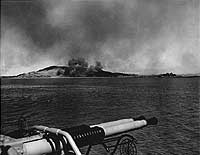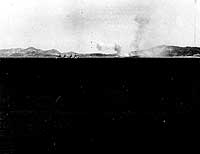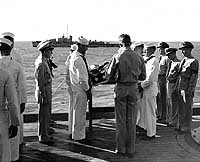
The Inchon assault formally began with an air and gunfire bombardment of Wolmi-Do island on 13 September 1950. Six U.S. Navy destroyers led off that morning by steaming up the channel on the flooding tide, the better to avoid any waiting mines. Overhead, carrier planes bombed and rocketed Wolmi-Do, whose artillery batteries threatened the planned landing beaches. Further inland, other planes had been working for several days to isolate the Inchon area from enemy reinforcement.
The destroyers anchored off Wolmi-Do shortly after noon and began firing pointblank at targets there and along the Inchon waterfront. Their bombardment continued for about an hour, followed by heavier gunfire from cruisers and more air attacks. North Korean return fire damaged three of the destroyers, killing an officer on USS Lyman K. Swenson (DD-729). Wolmi-Do and other nearby targets were hit again the following day, with good results, and again just before landings began on the morning of 15 September.
This page features views of the pre-invasion bombardment of the Inchon defenses, beginning on 13 September 1950.
For a special image selection on the Inchon Invasion, plus
links to additional pictures of that Operation, see:
For views of other aspects of the September-November United
Nations' offensive in Korea, see:
For a precis of our Korean War images, and links to more
comprehensive pictorial coverage of that conflict, see:
If you want higher resolution reproductions than the Online Library's digital images, see: "How to Obtain Photographic Reproductions."
Click on the small photograph to prompt a larger view of the same image.
|
Photo #: 80-G-419905 Inchon Invasion, September 1950 Five U.S. Navy destroyers steam up the Inchon channel to bombard Wolmi-Do island on 13 September 1950, two days prior to the Inchon landings. Wolmi-Do is in the right center background, with smoke rising from air strikes. The ships are USS Mansfield (DD-728); USS DeHaven (DD-727); USS Lyman K. Swenson (DD-729); USS Collett (DD-730) and USS Gurke (DD-783). Official U.S. Navy Photograph, now in the collections of the National Archives. Online Image: 45KB; 740 x 595 pixels Reproductions of this image may also be available through the National Archives photographic reproduction system. |
 |
|
Photo #: 80-G-420044 Inchon Invasion, September 1950 Wolmi-Do island under bombardment on 13 September 1950, two days before the landings at Inchon. Photographed from USS Lyman K. Swenson (DD-729), one of whose 40mm gun mounts is in the foreground. Sowolmi-Do island, connected to Wolmi-Do by a causeway, is at the right, with Inchon beyond. Official U.S. Navy Photograph, now in the collections of the National Archives. Online Image: 104KB; 740 x 600 pixels Reproductions of this image may also be available through the National Archives photographic reproduction system. |
 |
|
Photo #: NH 96980 Inchon Operation, September 1950 A Chaplain reads the Last Rites service as Lieutenant (Junior Grade) David H. Swenson is buried at sea from USS Toledo (CA-133), off Inchon, Korea. He had been killed by North Korean artillery while his ship, USS Lyman K. Swenson (DD-729) was bombarding enemy positions on Wolmi-do island, Inchon, on 13 September 1950. Lyman K. Swenson is in the background, with her crew at quarters on deck. Official U.S. Navy Photograph, from the "All Hands" collection at the Naval Historical Center. Online Image: 101KB; 740 x 625 pixels |
 |
For a special image selection on the Inchon Invasion, plus
links to additional pictures of that Operation, see:
For views of other aspects of the September-November United
Nations' offensive in Korea, see:
For a precis of our Korean War images, and links to more
comprehensive pictorial coverage of that conflict, see:
If you want higher resolution reproductions than the Online Library's digital images, see: "How to Obtain Photographic Reproductions."
Page made 11 October 1999
Picture caption corrected 6 February 2001